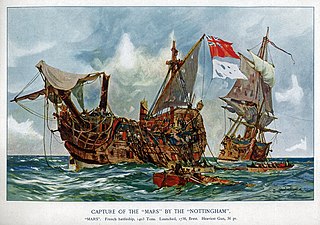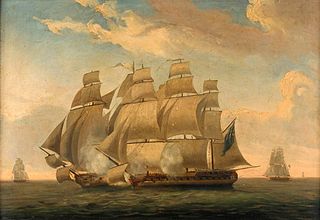
HMS Africa was a 64-gun third-rate ship of the line of the Royal Navy, launched by William Barnard at Barnard's Thames Yard in Deptford on 11 April 1781.

HMS Magnanime was a 64-gun third-rate ship of the line of the Royal Navy, launched on 14 October 1780 at Deptford Dockyard. She belonged to the Intrepid-class designed by Sir John Williams and later was razeed into a 44 gun frigate.

HMS Nottingham was a 60-gun fourth-rate ship of the line of the Royal Navy, built at Deptford Dockyard and launched on 10 June 1703. She was the first ship to bear the name.
Barrington Dacres was an officer of the Royal Navy, who saw service during the French Revolutionary and Napoleonic Wars. He eventually rose to the rank of Post-Captain. He did not see action in many significant engagements, and is chiefly remembered for the accidental loss of his ship to the French, and for the unsuccessful chase of two French ships in the English Channel. He did command a number of ships of the line under several of the leading naval commanders of his time. His early death, however, prevented him from achieving the same seniority and degree of fame as his relatives did.
Admiral Sir Robert Laurie, 6th Baronet KCB was an officer of the Royal Navy who served during the French Revolutionary and Napoleonic Wars. He rose through the ranks after his entry, fighting as a lieutenant under Howe at the Glorious First of June, and being wounded in the action. Shortly after he served in the West Indies and off the American coast, where he operated successfully against enemy raiders and privateers, he was rewarded with the command of the frigate HMS Cleopatra, and in 1805 fought an action with a superior French opponent, Ville de Milan. He was forced to surrender his ship after several hours of fighting, but so heavily damaged the Frenchman that both she and the captured British vessel were taken shortly afterwards when another British frigate HMS Leander, arrived on the scene. Rewarded for his valour and honourably acquitted for the loss of his ship, he served throughout the rest of the Napoleonic Wars. He rose to flag rank after the end of the wars, eventually dying in 1848 with the rank of Admiral of the White. He inherited a baronetcy in 1804, but this became extinct upon his death.

Charles Lydiard was an officer of the Royal Navy who served during the French Revolutionary and Napoleonic Wars.
Admiral Sir Lawrence William Halsted GCB was an officer of the Royal Navy who served during the American War of Independence and the French Revolutionary and Napoleonic Wars.

The Battle of the Mona Passage was a naval engagement on 19 April 1782 taking place in the aftermath of the Battle of the Saintes between Britain and France during the American Revolutionary War. A British fleet under Rear-Admiral Sir Samuel Hood, pursued a small French fleet under Georges-François de Framond which had managed to escape the victorious British fleet a week earlier. The two fleets met and engaged at the Mona Passage where the British overtook and captured four French ships, two of which were 64-gun ships of the line.

The action of 23 August 1806 was a minor naval battle of the Napoleonic wars, fought off the coast of Spanish Cuba near the port of Havana. The Spanish frigate Pomona was captured by the frigates HMS Anson and HMS Arethusa under the commands of Captain Charles Lydiard and Charles Brisbane respectively. As well as the frigate being captured, a shore battery was silenced and a fleet of gunboats was defeated.
HMS Laura was an Adonis-class schooner of the Royal Navy, launched in 1806 at Bermuda. Laura served during the Napoleonic Wars before a French privateer captured her at the beginning of the War of 1812. She was briefly an American letter of marque before the British recaptured her in 1813. Despite having recaptured her, the British did not return Laura to service.
The action of 6 December 1782 was an naval encounter primarily fought between HMS Ruby and the French ship Solitaire off the coast of Martinique. Ruby easily defeated Solitaire.
The action of 1 May 1781 was a naval engagement nearly 210 miles off the Port of Brest in which HMS Canada, a 74-gun third rate of the Royal Navy under Captain George Collier chased, intercepted and captured the 40-gun Spanish frigate Santa Leocadia, captained by Don Francisco Wenthuisen.
Solomon Ferris was an officer in the Royal Navy who served during the American War of Independence and the French Revolutionary and Napoleonic Wars.

Charles Inglis was an officer of the Royal Navy who saw service during the War of the Austrian Succession, the Seven Years' War, and the American War of Independence, rising to the rank of rear-admiral.

Le Magnanime was originally a 74-gun ship of the line of the French Navy launched in 1744 at Rochefort. Captured on 12 January 1748, she was taken into Royal Navy service as the third rate HMS Magnanime. She played a major part in the 1757 Rochefort expedition, helping to silence the batteries on the Isle of Aix, and served at the Battle of Quiberon Bay in 1759 under Lord Howe, where she forced the surrender of the French 74-gun Héros. Following a survey in 1770, she was deemed unseaworthy and was broken up in 1775.

Sir Charles Saxton, 1st Baronet was an officer of the Royal Navy who saw service during the War of the Austrian Succession, the Seven Years' War, the American War of Independence and the French Revolutionary and Napoleonic Wars, rising to the rank of captain.
The action of 4 September 1782 was a small naval engagement fought off the Île de Batz between a French naval frigate, Hébé, and a Royal Naval frigate, HMS Rainbow. This battle was notable as the first proper use of a carronade, and so effective was this weapon that the French commander promptly surrendered just after the first broadside.
The action of 12 December 1779 was a minor naval engagement that took place in the Bay of Honduras during the American Revolutionary War between a British Royal naval Fourth-rate fifty gun ship and a fifty gun Spanish privateer.
The Battle of Guadeloupe or the Action of 21–22 December 1779 was a naval engagement that took place off the French island of Guadeloupe in the Caribbean during the American Revolutionary War between three Royal Navy ships and three French Navy frigates. The Royal Navy under Joshua Rowley sighted and promptly chased the French frigates, all of which were captured after a brief fight.

The action of 2 January 1783 was a minor naval battle that took place in the Caribbean Sea during the last stages of the American War of Independence. Severe fighting between a Royal Navy frigate HMS Magicienne and a French frigate Sibylle went on for nearly two hours, but in that time both frigates were reduced to wrecks.










